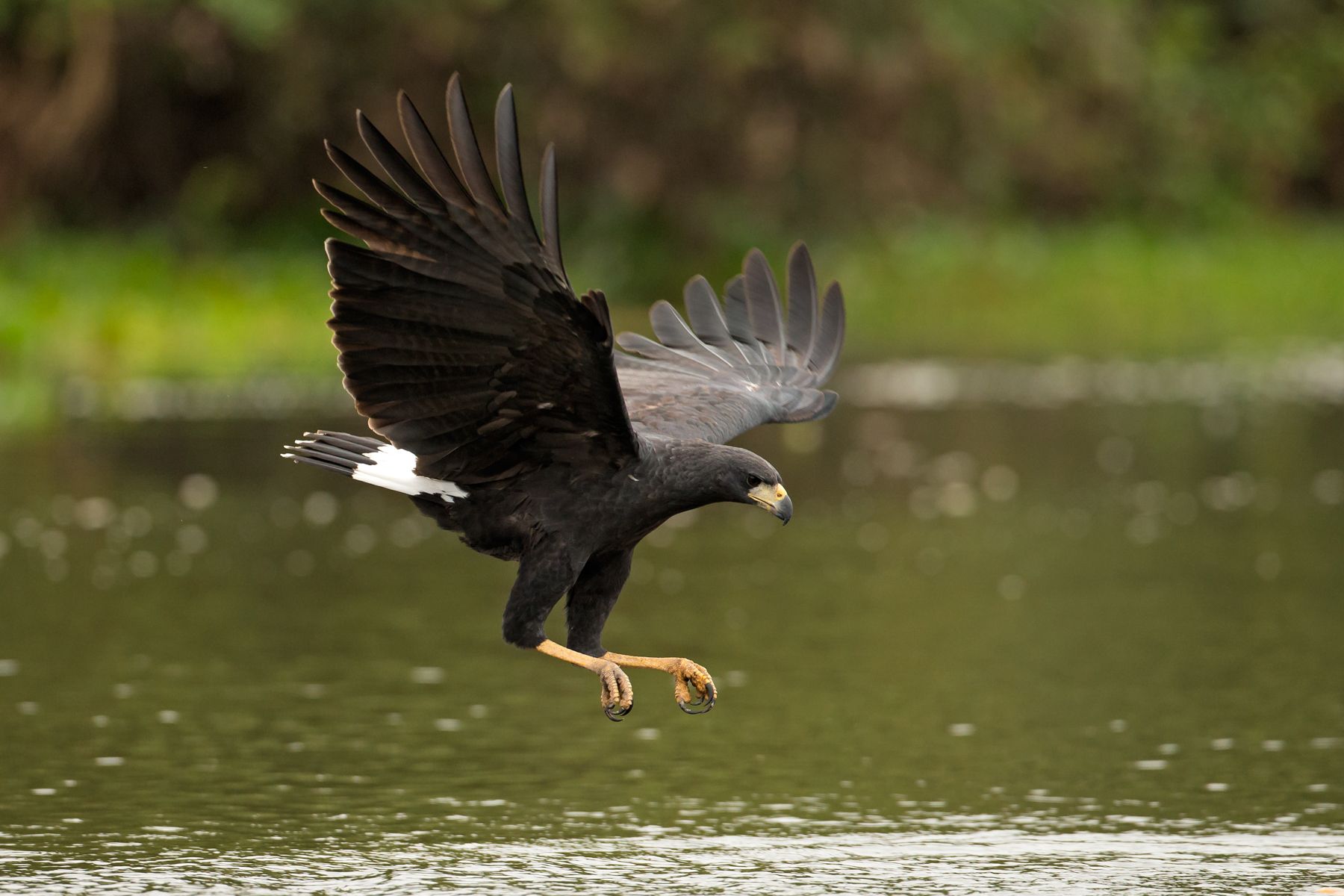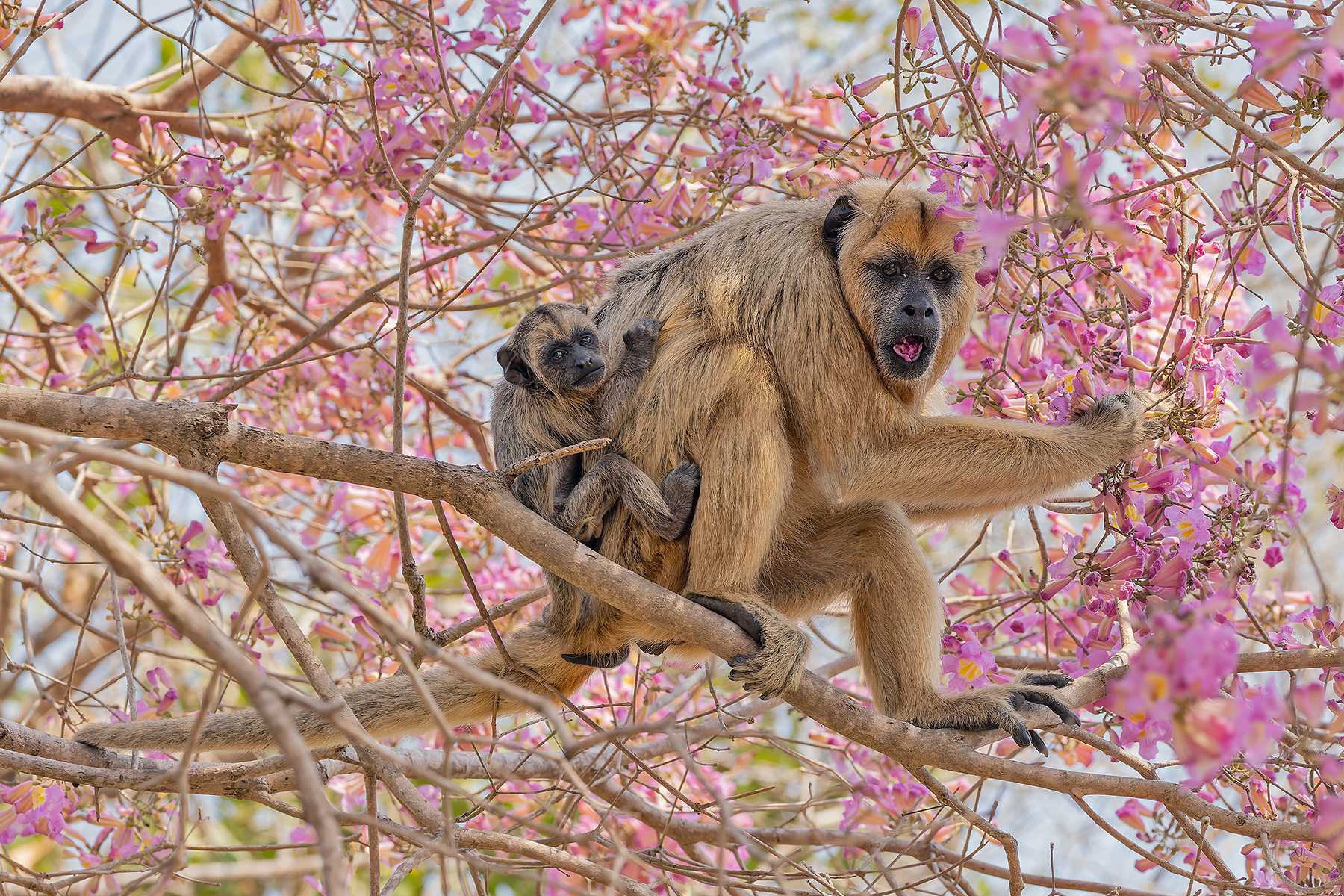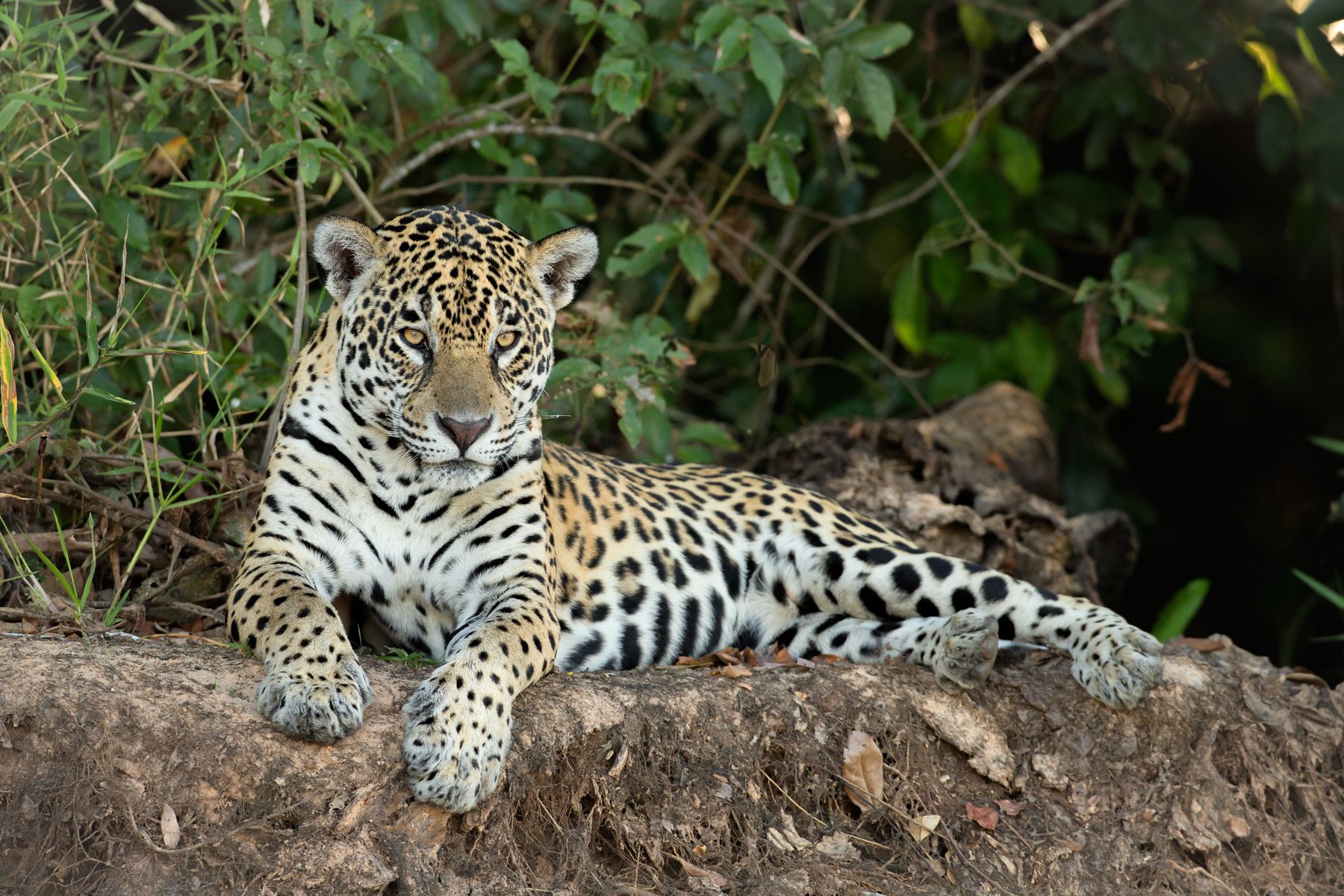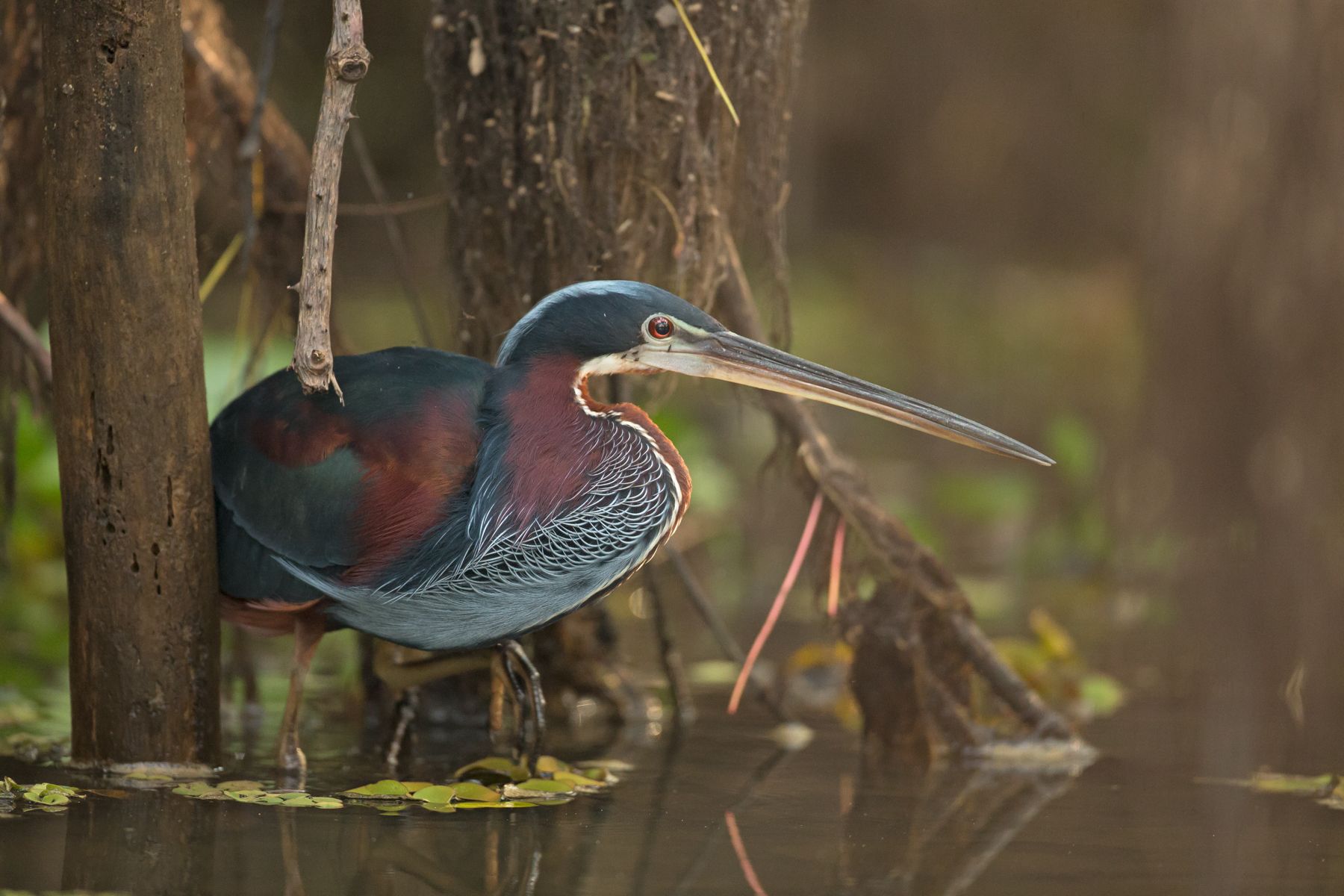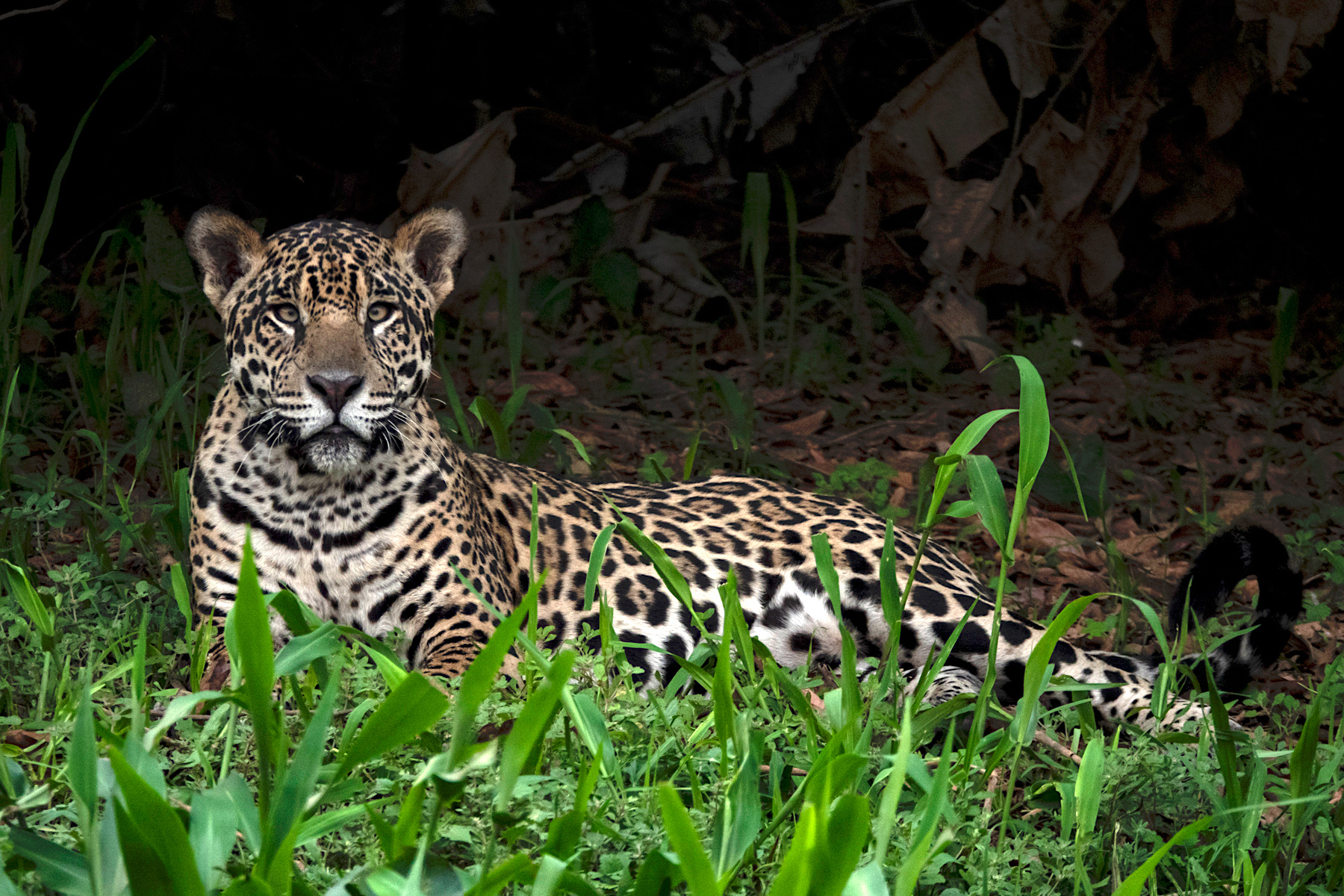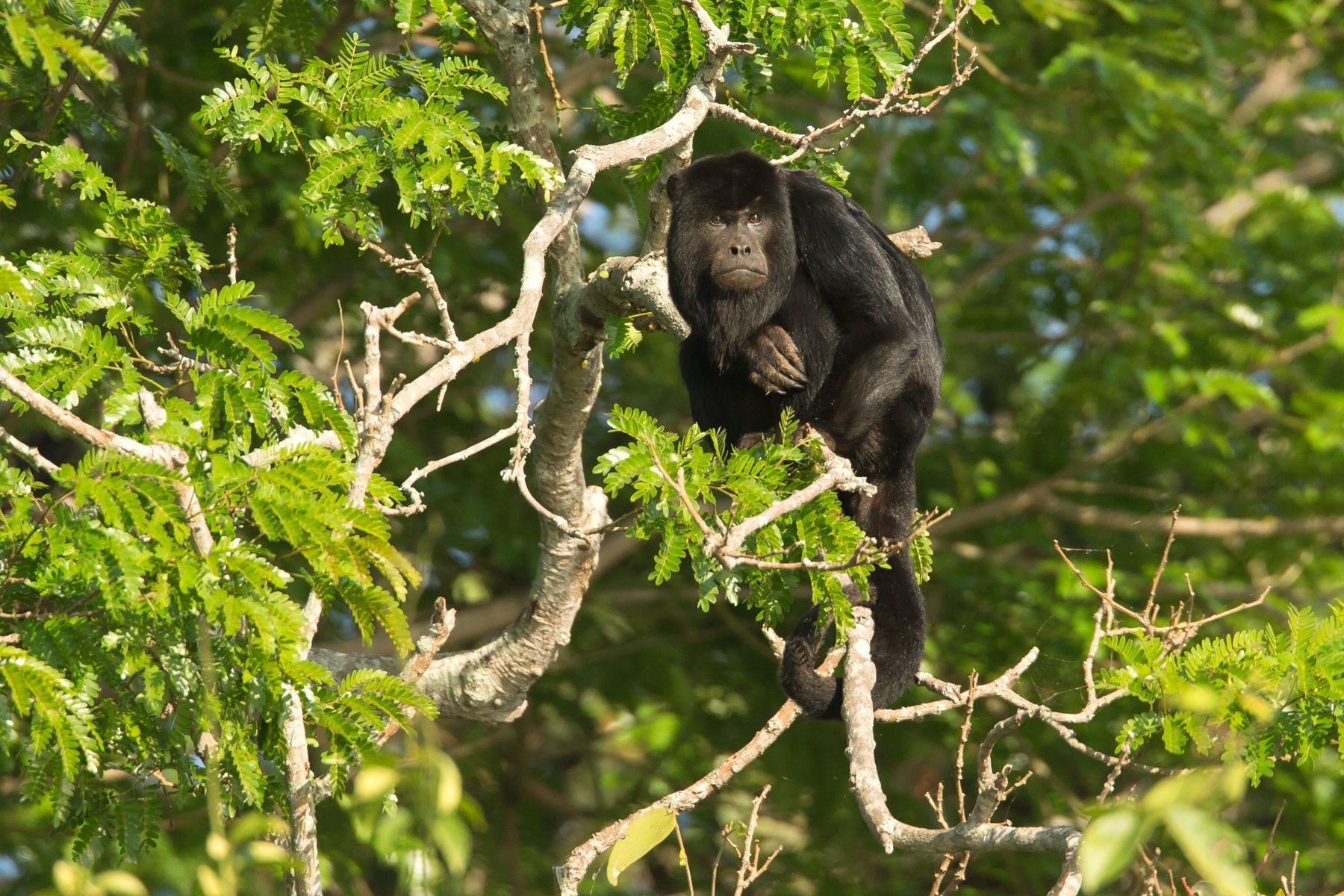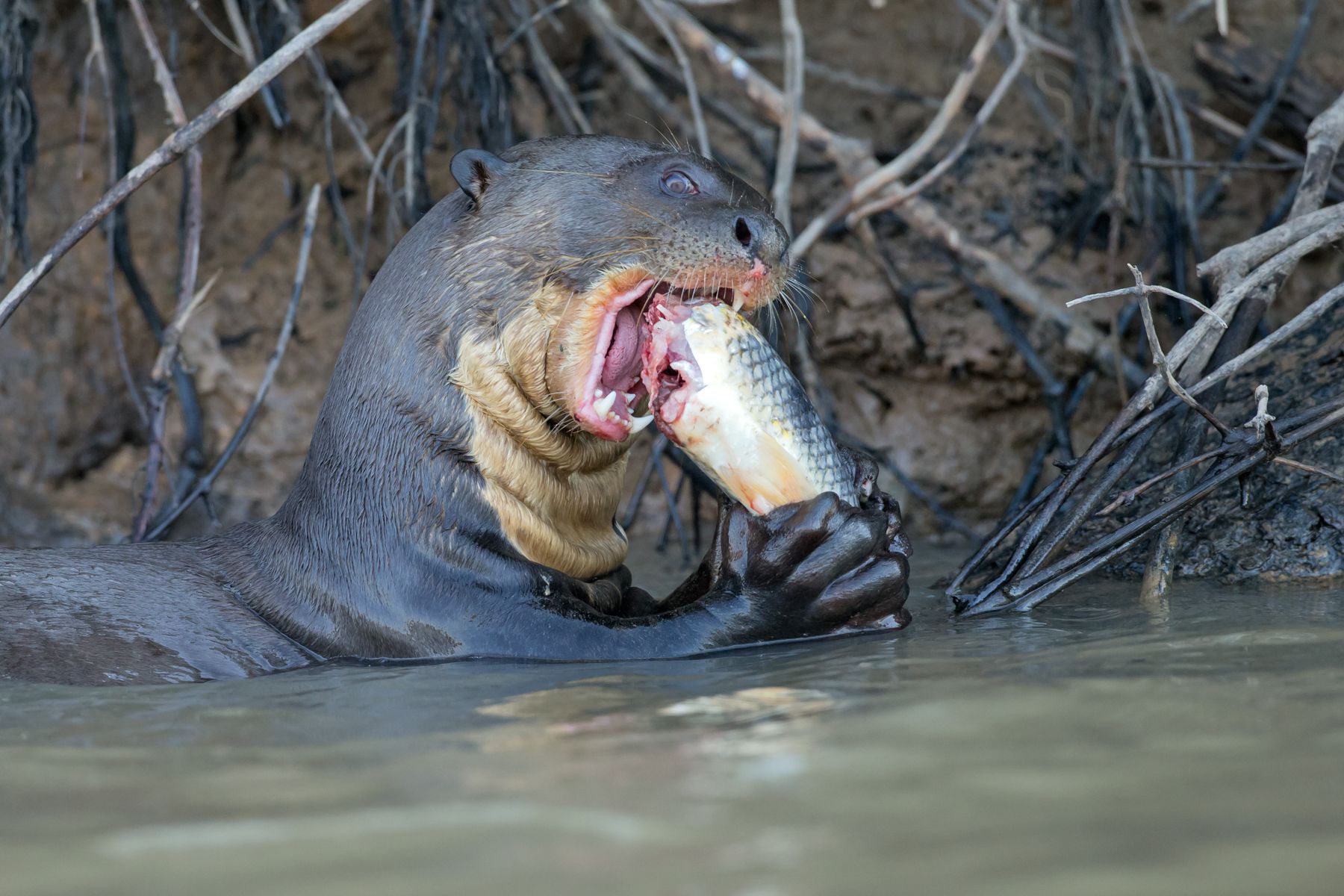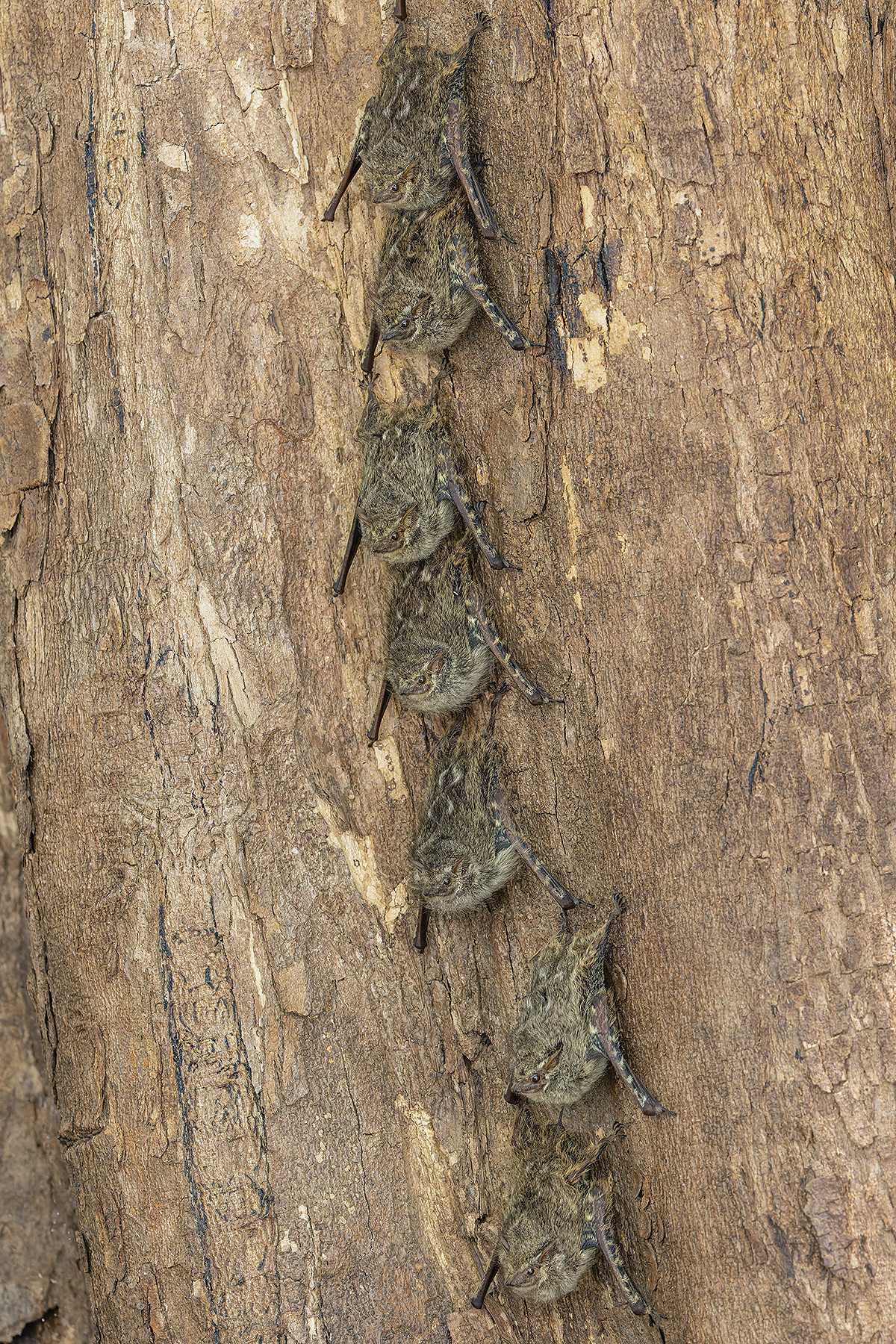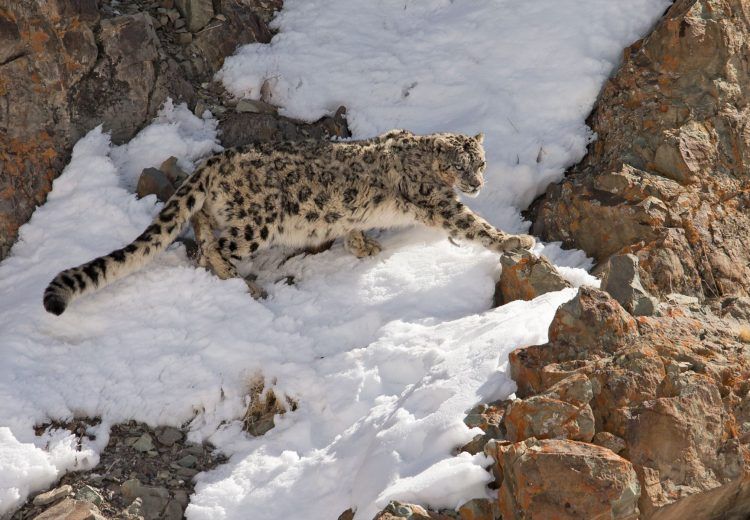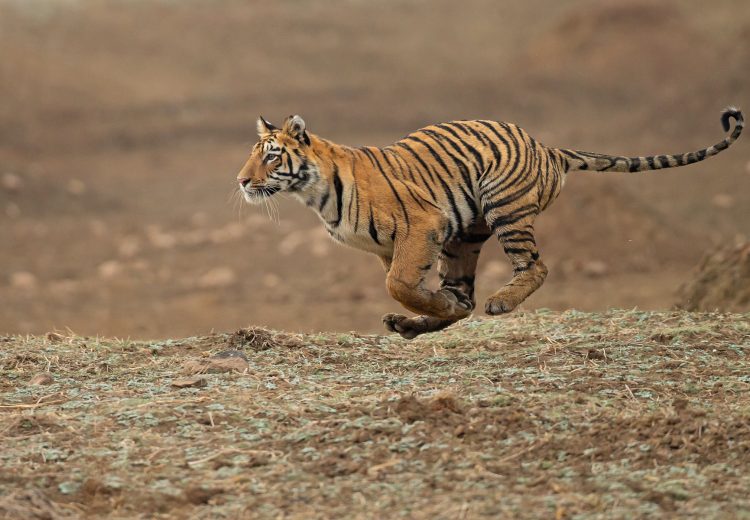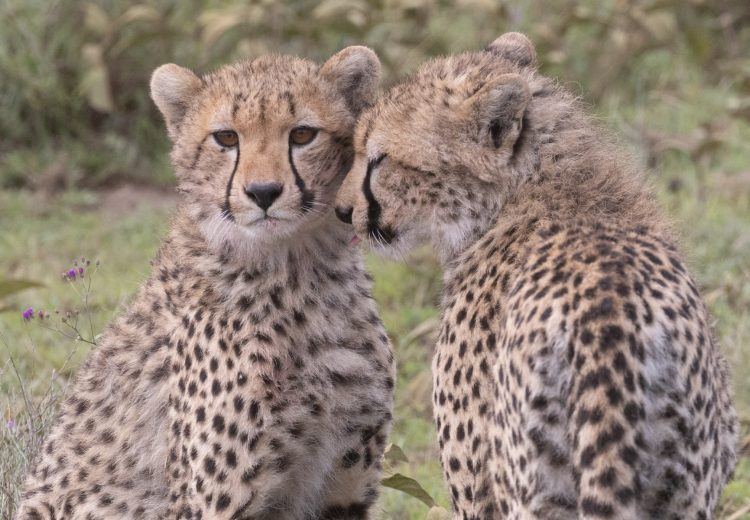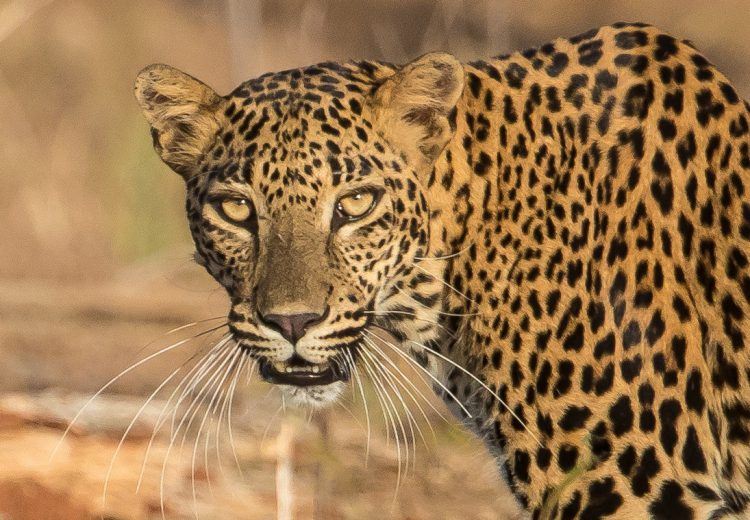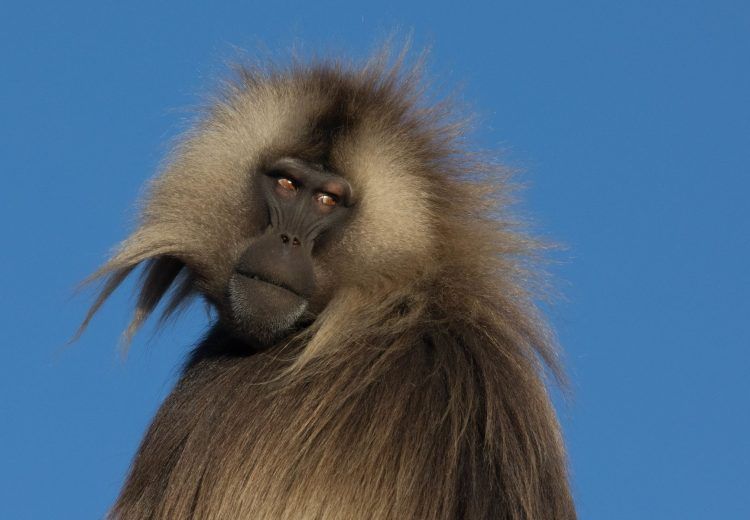South America (including Galapagos)
BRAZIL’S PANTANAL: JAGUARS AND SO MUCH MORE – South America’s best wildlife photography destination

















































































We don't often encounter snakes in the Pantanal. This is a beautiful Matto Grosso Lancehead (Image by Mike Watson)

A Jaguar prowls around the shoreline of a river in the Pantanal, Brazil (Image by Mike Watson)

Sometimes we just find the wildlife star of the Pantanal having a siesta! (Image by Mike Watson)

Up to 4 ocelots can visit the hide if you're lucky. Emerging out of the shadows, tempted by a few pieces of well placed meat... (Image by Luke Massey)

Hyacinth Macaws are always a highlight of our Pantanal tours (image by Pete Morris)

A Crab-eating Fox on the run in the Pantanal (Image by Mike Watson)

Some Pantanal Jaguars seem to specialise in attacking and eating caimans (Image by Mike Watson)

Portrait of a Yacare Caiman (image by Pete Morris)

Back-lit Southern Crested Caracara at dawn at Rio Claro (Image by Mike Watson)

The Toco Toucan seems strangely familiar. Ah yes, those Guinness adverts! (Image by Michael Watson)

When sat up on the bank sides, the jags are often on the lookout for prey, be it a grazing capybara or a passing heron (Image by Luke Massey)

Rays of sunshine illuminate a Jaguar sleeping on a log (Image by Mike Watson)

A Green Iguana with (sadly) two large ticks on its neck (image by Pete Morris)

The secretive Sungrebe likes the river margins (Image by Mike Watson)

A Great Black Hawk swoops down to capture aquatic prey (Image by Mike Watson)

Back-lit Capybara at Rio Claro (Image by Mike Watson)

A striated heron uses giant lily pads to its advantage, a floating fishing perch (Image by Luke Massey)

The attractive Green Kingfisher is a common bird of the Pantanal (Image by Mike Watson)

Look at my tongue! A Jaguar yawns on a hot Pantanal afternoon (Image by Mike Watson)

The Capybara is the world's largest rodent, being almost as large as a pig (Image by Mike Watson)

A large male Jaguar stalks the riverbank in Brazil's Pantanal (Image by Mike Watson)

Portrait of a Yacare Caiman in the Pantanal (Image by Mike Watson)

To see one jaguar is fantastic, but to see two hunting together, that really is being spoilt! (Image by Luke Massey)

A wild Jaguar stalks a Jabiru in the Pantanal (Image by Mike Watson)

Portrait of a beautiful Jaguar sitting in a tree in the Pantanal (Image by Mike Watson)

Black Howler Monkeys make quite a racket at dawn and dusk (Image by Mike Watson)

A female Black and Gold Howler Monkey with its youngster in a flowering Ipe tree (image by Pete Morris)

The huge Jabiru stork stands as tall as a man (Image by Mike Watson)

A black collared hawk admires the rising sun (Image by Luke Massey)

Giant Anteater portrait. What a snout! (Image by Mike Watson)

A Jaguar rests by the riverside in the Pantanal, unafraid of our presence (Image by Mike Watson)

The secretive Agami Heron loves quiet Pantanal backwaters (Image by Mike Watson)

Stunning views of a Monk Parakeet flock in flight (image by Pete Morris)

A Jaguar prowls along the river's edge (image by Mike Watson)

A pair of Chestnut-bellied Guans rival each other in flight in the Pantanal (Image by Mike Watson)

A Capped Heron flies in to feed (Image by Mike Watson)

The strange-looking Great Potoo at a daytime roost (Image by Mike Watson)

Yacare Caiman portrait (Image by Mike Watson)

Two Southern Crested Caracaras on an old piece of farm machinery (Image by Mike Watson)

The Pantanal isn't all about Jaguars. Ocelots also steal the feline show (image by Pete Morris)

The brothers could be trekked down far up the Rio Cuiaba hunting the banks, or resting in the shade (Image by Luke Massey)

On the beach (Image by Mike Watson)

A Great Horned Owl in the Pantanal of Brazil (Image by Mike Watson)

A Yellow Anaconda enters the river with its tongue forked to test the waters (image by Pete Morris)

Taking a break in the shade of the canopy (Image by Luke Massey)

The huge Black-and-white Tegu lizard (Image by Mike Watson)

Portrait of a stunning Jaguar creeping through a log in the Pantanal (Image by Mike Watson)

Black-tufted Brown Capuchin (Image by Mike Watson)

A crimson crested woodpecker feeds its chick within the grounds of Porto Joffre Hotel (Image by Luke Massey)

Their low, growling hoots are amazingly far-carrying (image by Mike Watson)

A beautiful Toco Toucan in flight in the Pantanal region of Brazil (Image by Mike Watson)

The huge Ringed Kingfisher favours the broader river channels (Image by Mike Watson)

When a Giant Otter crunches down a fish one can hear the noise from 50 metres! Pantanal, Brazil (Image by Mike Watson)

Jabiru with its three older youngsters (image by Pete Morris)

The lovely Golden Lion Tamarin (Image by Mike Watson)

On the move the tegu looks even more impressive (Image by Mike Watson)

A Nanday Parakeet calls to its flock-mates 9image by Mike Watson)

Southern Screamer screaming during flight (image by Pete Morris)

A Jaguar swims across a channel (Image by Mike Watson)

A smart white headed water tyrant stands proud on the bank side (Image by Luke Massey)

Close up of a curious Coati (image by Pete Morris)

Chestnut-bellied Guans stealing the horses' food (Image by Mike Watson)

The elusive tapir, South America's largest land mammal, and one we were lucky enough to encounter on the Rio Piquiri (Image by Luke Massey)

Portrait of a Crab-eating Fox (image by Pete Morris)

An unlucky water snake put up a great fight but the Striated tiger heron eventually subdued and swallowed it (Image by Luke Massey)

Giant otters devour a couple of unlucky plecostomus' (Image by Luke Massey)

Ocelot, could you be the most beautiful cat in the world? (Image by Mike Watson)

Chicha seeds are irresistible to a wide range of creatures, including the Toco toucan who plays an important role in the seed dispersal of this tree (Image by Luke Massey)

The huge Hyacinth Macaw is an iconic bird of the Pantanal (Image by Mike Watson)

Reflection shot of a beautiful Agami Heron in the Pantanal (Image by Mike Watson)

Santa Teresa's Ocelot hide gives unrivalled access and views to this incredibly elusive, stunning little cat (Image by Luke Massey)

A Brazilian Long-nosed Bat colony (image by Pete Morris)

The punk-like Guira cuckoo, gregarious and common in the Pantanal (Image by Luke Massey)

A Jabiru takes flight to escape a prowling Jaguar (Image by Mike Watson)

Portrait of a wild Jaguar sitting on the river bank in the Pantanal (Image by Mike Watson)

The tangled roots that line the bank can make photos tricky at times, but when the jaguar emerges from them, it is worth the wait (Image by Luke Massey)

A Toco Toucan does its party trick at Pouso Alegre (Image by Mike Watson)

Giant Otters are still frequently seen in the Pantanal, where they are a star wildlife attraction (Image by Mike Watson)

Portrait of an Anhinga (Image by Luke Massey)
|
Sunday 17th August –
Thursday 28th August 2025 Leader: Oliver Krüger |
12 Days | Group Size Limit 7 (full) |
|
Saturday 15th August –
Wednesday 26th August 2026 Leader: Oliver Krüger |
12 Days | Group Size Limit 7 |
BRAZIL JAGUAR & WILDLIFE PHOTOGRAPHY TOURS WITH WILD IMAGES
Brazil’s remarkable Pantanal is simply one of the natural wonders of the world. It is a vast watery wilderness harbouring one of the greatest wildlife concentrations on the planet. In fact we think it is not just the best place for wildlife in Brazil but also one of the world’s best wildlife photography tour destinations in terms of number and quality of opportunities and subjects. We will visit the northern part of this huge expanse of wetlands, which is nowadays known as The place to photograph the magnificent Jaguar, and we will have six days of boat trips on the Rio Cuiabá and its tributaries devoted to finding them.
A very impressive supporting cast of other photogenic wildlife in this part of Brazil includes the impressive Giant Otter, the extraordinary Giant Anteater and an enormous number of caimans. Around 1000 bird species have been recorded in the Pantanal, far too many to mention here, but some of the most obvio ones that we photographers want to capture include the very attractive and sought-after Hyacinth Macaw, the world’s biggest parrot, and the Toco Toucan, the world’s biggest toucan. The impressive Jabiru, the world’s biggest stork, feeds alongside a throng of herons, storksus, egrets, ibises and other waterbirds. In fact the sheer number of wildlife photography subjects in this corner of Brazil is truly mind-boggling.
Called ‘Terra de Ninguem’ (No Man’s Land) by the Brazilians, the Pantanal is a vast alluvial plain, half the size of France, situated at only 100 metres (330ft) above sea-level and inhabited by just a few thousand people. Receiving the run-off from the Planalto Highlands of southwestern Brazil, this immense and seasonally watery world is essentially a huge inland river delta, which has been the subject of some awe-inspiring wildlife films.
The main attraction of the Pantanal for the wildlife photographer is the near certainty of multiple encounters with the most powerful cat in the New World, the fabled Jaguar. Although this magnificent animal is still quite widespread in Central and South America, occurring from northern Mexico south to central Argentina (including most of Brazil), it is only rarely seen elsewhere in its range and is more commonly detected by camera traps. Jaguars are usually associated with large tracts of dense rainforest, but it is now known that they feel equally at home in more open habitats, with a very marked preference for the immediate vicinity of watercourses. Hunting of Jaguars ceased a long time ago in the Pantanal of Brazil, and as a direct result these magnificent creatures have gradually become less afraid of people, sop much so in recent years that a boatload of wildlife photographers seem to faze few of them! Needless to say, this increasing unconcern for visitors is making for some truly wonderful photography.
The Pantanal holds the highest density of this enigmatic creature and is the world’s foremost locale for viewing and photographing Jaguars. The most reliable way of seeing this otherwise elusive cat is to take boat trips on the rivers, as they like to loaf during the day at the edge of a river or on sandbanks. As we patrol the waterways we will be keeping a constant lookout for this spotted beauty, which is regularly active by day here, in contrast to its more crepuscular and nocturnal habits elsewhere. The largest individuals of the Jaguar live here in the southern Mato Grosso of Brazil, where average adults usually weigh twice as much as their relatives in Central America at up to 140 kilograms (300 pounds)! We stand a high chance of encountering this cold-eyed, exquisite marvel on most of our outings and we may well get some great photography encounters.
Although the Jaguar dominates the scene in the Pantanal as the keystone predator, they would not be here were there not a healthy population of prey animals. Capybaras, the world’s largest rodents, are a favourite prey of the big cat and occur all over the Pantanal, leading a semi-aquatic life. Many Pantanal Jaguars also prey on caimans, their ultra powerful jaws enabling them to bite through the crocodiles’ skulls!
We should also see the awesome Giant Otter. Several family parties inhabit the narrower stretches of the rivers and, sometimes, inquisitive individuals come to inspect the boat and can then be photographed at minimal range.
Other mammals that we have a fairly good chance of encountering during our exploration of the Pantanal include Crab-eating Fox, South American Coati, Black-striped Tufted Capuchin, Black Howler Monkey, the curious-looking Brazilian Tapir, and Marsh Deer.
We will also be stunned by the masses of crocodilians here. It is estimated that as many as 10 million Yacare Caimans inhabit the waters of the Pantanal – the largest single concentration of crocodilians in the world! The sheer quantity of these creatures in some parts of the Pantanal makes for some interesting photography.
As well as our comprehensive series of boat trips on the Rio Cuiabá in search of the wonderful Jaguar and other wildlife, we will spend some time exploring other excellent sites for wildlife photography along the famous Transpantaneira, a dirt road that runs from near Cuiabá southwards towards the border area between Brazil and Bolivia. The road has more than a hundred bridges and runs through a variety of habitats including pastures, palm groves, gallery woodland, scrubby growth, meandering rivers, ponds and extensive flooded marshes.
Photographic opportunities abound along the Transpantaneira. Here we can drive within metres of the gigantic nests of the huge and grotesque Jabiru stork, which seem to balance precariously on the crowns of the scattered trees. The weird haunting cries of Southern Screamers are a common early morning sound, as numerous herons, egrets and ibises fly in to throng the marshes. Pairs of reclusive Plumbeous Ibises feed in the shallows, away from the more boisterous species.
Raptors are very well represented in the Pantanal and subjects for good images may include Black and Lesser Yellow-headed Vultures, Snail Kites, Crane, Savanna, Black-collared, Roadside and Short-tailed Hawks and Southern Caracara (or Southern Crested-Caracara).
Away from the water, a different set of birdlife abounds in the scattered patches of gallery forest and in the distinctive savanna habitat, called cerrado, which is so characteristic of this part of Brazil. These palm-rich forests are the stronghold of the world’s largest parrot, the spectacular Hyacinth Macaw. We will watch these huge birds flapping lazily towards their roosting trees, their rich purplish-blue feathers glowing in the last rays of the setting sun. The world population of this fantastic creature, which surely epitomizes the wildness and uniqueness of the Pantanal, is now sadly reduced to just a few thousand birds (most of which are to be found in Brazil), owing to illegal trapping for the cagebird trade. In this area, however, the birds are better protected and often allow a close approach for some excellent photography.
The Hotel Pantanal Norte versus the Flotel
We often see Pantanal wildlife photography tour operators extolling the virtues of the Flotel, which is a bit upriver from Puerto Jofre town, over staying in Puerto Jofre itself. Well, we have nothing against the Flotel, but we stay at the best hotel in town, the Hotel Pantanal Norte, as a conscious decision, because we think it offers a better all-round experience for our guests.
In the first place we use a very fast and powerful boat for our tours, so the Flotel area is only about 25 minutes upriver for us. We can easily go back to our hotel for lunch and a midday break in between photographing Jaguars and other wildlife, and we always do.
The reality is that there are fun aspects to staying on a houseboat, but it inevitably lacks the spacious grounds and large rooms of the Hotel Pantanal Norte, which in our view is a higher quality accommodation and well worth the minor time penalty involved. The hotel grounds can be good for wildlife photography (we often see Hyacinth Macaws there, not to mention ibises and other waterbirds at very close range), so it is a nice place to spend some time. In the evening, mosquitoes are not an issue at the hotel although they can be upriver.
Naturally we don’t miss any of the prime times of day (early and late) in the best Jaguar habitats, and the only ‘toll’ for staying at a nice hotel is a bit of extra journey time.
Accommodation & Road Transport
The hotels/lodges used during our Pantanal wildlife photography tour are of good standard throughout. Road transport is by air-conditioned minibus and roads in this part of Brazil are mostly good.
Walking
The walking effort in Brazil’s Pantanal is very easy throughout.
Climate
Generally warm or hot, dry and sunny at this season in the Pantanal of Brazil. Overcast weather is quite regular, however, and there may be some rain. The humidity is moderate.
Photographic Equipment
During our Brazil’s Pantanal wildlife photography tours, the most used telephoto lens focal lengths with a full-frame DSLR or mirrorless are usually between 300-600 mm (sometimes even longer is useful). Telephotos of 200 mm or less tend to be of limited use on this tour.
The Pantanal has few panoramic views and so ultra-wide-angle is only occasionally useful. Of more use is to cover the range 24-70/100 mm.
There will be some opportunities to use a macro lens, if you have one.
All the focal lengths mentioned above relate to full frame cameras. Please adjust as appropriate for crop sensor and micro four thirds cameras.
You can also get wonderful results throughout this Pantanal wildlife photography tour, with many subjects, with a high quality ‘bridge’ camera with an 18-20x or higher optical zoom and a wide-angle setting which is equivalent to 24mm.
A tripod cannot be effectively used on the boats (there is insufficient space), but a monopod can be helpful if you use a heavy telephoto.
If you have questions about what equipment you ought to bring, please contact us.
RIO DE JANEIRO PHOTOGRAPHY STOPOVERS
We can easily arrange stopovers in ‘Rio’, one of the world’s truly iconic cities, with assisted transfers and expert local guides to take care of you while you admire some of Brazil’s most iconic landmarks such as Sugar Loaf Mountain, the famous statue of Christ the Redeemer, the Botanical Gardens as well as the famous beaches of Ipanema and Copocabana. A couple of hours drive to the north of Rio, the gorgeous and endangered Golden Lion Tamarin monkey can be found easily in private nature reserves, surely one of the world’s most beautiful primates. Please contact our office for more information.
VIEW OUR GUESTS’ PHOTOS
2023 has been a wonderful year for me with the cats. Leopards, tigers and lions. The icing on the cake was the prolonged close encounter I had with a snow leopard in Ladakh, India, when I was desperately searching for one along with Mike Watson and Wild Images. The thrill of being with this ghost of the Himalayas at less than 20 meters distance will be etched forever in my psyche! So when I was looking up this Wild Images tour to the Pantanal to be with the jaguars, I convinced myself that the stars were wonderfully aligned for me + Mike Watson + Wild Images + cats + the year 2023 for me to get lucky once again!! This was my first trip to mainland South America and boy, was I glad I made the decision to go there! It was a novel experience for me to be in a boat all the time as we explored the Pantanal looking for the famed cat and taking some amazing pics. The jaguar sightings were phenomenal. In the five-and-a-half days that I was there, we were lucky to have innumerable sightings of the jaguar. 19? 20? or was it 22? It was all possible due to the expert handling of the boat by Alex the boatman, sharp eyes of Marlon Mendez the guide under the astute leadership of Mike Watson. The jaguar literally catwalked for us on the ramps of the Pantanal ! And what poses!! Drinking water, swimming, stalking, eating grass, lazing around, targeting a caiman, leaping for the caiman kill, carrying the caiman up a steep river bank, hunting a capybara, beach walk, yawning, shrugging and spraying water off its fur………….. possibly the only thing they did not do for us was dancing to some rhythm and introducing us to their young ones. Add to this experience some wonderful stay facilities with exquisite, personalized vegetarian food and we saw that perfection just got better. I would especially thank Mike for letting me take a detour on the last day and Bianca for being my guide for that day for some fantastic encounters with the Giant Anteaters, armadillo, red-legged seriema and other birds. This tour was one experience that might be tough to beat but I am sure Wild Images and Mike are up to the challenge! To see a gallery of KC’s beautiful images please click here.
Photographic Highlights
- Exploring the myriad channels of the sleepy Rio Cuiabá and its tributaries in search of Jaguars on South America’s number one wildlife photo tour
- A high chance of repeated good photographic encounters with Jaguars, taking a nap in some nice light, prowling a riverbank or, if we are very lucky, a caiman kill
- A family of hyperactive Giant Otters hunting all around our boat, the younger ones squealing with delight when mum has caught a fish
- Good chance of an audience with the superb Ocelot at a purpose-built viewing station
- Multiple sightings of Hyacinth Macaws and Toco Toucans - the world's biggest parrot and toucan!
- Jabiru, the world's biggest stork and a host of other herons, egrets and ibises thronging the fish-filled pools on the Pantanal
- A wide variety of other colourful and photogenic Neotropical bird species at feeding stations by our lodges along the Transpantaneira
- A slow motion, close encounter with the weird-looking Giant Anteater, one of South America’s most iconic animals
- A family of Capybaras, the world’s biggest and dumbest-looking rodent, slumbers on the riverbank, next to one of the Pantanal’s two million(!) Yacare Caiman
- A Crab-eating Fox trots past our rooms at the lovely and rustic Pouso Alegre Lodge
- The shy Brazilian Tapir swims across a quiet channel and hauls itself up a muddy riverbank and away in the forest, leaving its strange three-toed footprints behind
- The massive, prehistoric form of a Black-and-white Tegu, a lizard fortunately harmless to humans, lumbers into view
- A gorgeous Agami Heron, the beauty of the shadows, fishes in slow motion under the overhanging trees along the riverbank
- Attractive kingfishers perch here and there along the waterways of the Pantanal, we have never seen more of them anywhere
- Two special trees, the pink flowered Piuva and the yellow-flowered Cambara add splashes of colour to the landscape of the Pantanal
- It seems everything in Brazil is colourful, from the flora and fauna to the food and the wonderful people who look after us in the Pantanal!
OUTLINE ITINERARY
- Day 1: Morning tour start at Cuiabá. Drive to Pouso Alegre.
- Day 2: Pouso Alegre.
- Day 3: Pouso Alegre. Drive to Santa Tereza.
- Day 4: Santa Tereza.
- Day 5: Santa Teresa, then drive to Porto Jofre.
- Days 6-10: Exploring the Cuiabá River and tributaries for Jaguars. Overnights at Porto Jofre.
- Day 11: Final Jaguar boat trip then transfer to Piuval.
- Day 12: Piuval, then transfer to Cuiabá airport for afternoon tour end.
To see a larger map, click on the square-like ‘enlarge’ icon in the upper right of the map box.
To see (or hide) the ‘map legend’, click on the icon with an arrow in the upper left of the map box.
To change to a satellite view, which is great for seeing the physical terrain (and for seeing really fine details by repetitive use of the + button), click on the square ‘map view’ icon in the lower left corner of the ‘map legend’.
PRICE INFORMATION
Wild Images Inclusions: Our tour prices include surface transportation, accommodations, meals and entrance fees. We also include all boat trips.
Our tour prices also include all tips for local guides, drivers, boatmen and accommodation/restaurant staff.
Deposit: 20% of the total tour price. Our office will let you know what deposit amount is due, in order to confirm your booking, following receipt of your online booking form.
TO BOOK THIS TOUR: Click here (you will need the tour dates)
2025: provisional price £6110, $7790, €7430, AUD12380. Cuiabá/Cuiabá.
2026: provisional price £6350, $8090, €7720, AUD12860. Cuiabá/Cuiabá.
Single Supplement: 2025: £650, $830, €790, AUD1310.
Single Supplement: 2026: £670, $860, €820, AUD1360.
If you are travelling alone, the single supplement will not apply if you are willing to share a room and there is a room-mate of the same sex available.
This tour is priced in US Dollars. Amounts shown in other currencies are indicative.
Air Travel To & From The Tour: Our in-house IATA ticket agency will be pleased to arrange your air travel on request, or you may arrange this yourself if you prefer.
BRAZIL, PANTANAL: JAGUAR AND SO MUCH MORE WILDLIFE PHOTOGRAPHY TOUR: DETAILED ITINERARY
Day 1
Our Jaguar photography adventure begins this morning at Cuiabá, the capital of the state of Mato Grosso in southwestern Brazil. From here we will drive south across the cerrado towards the town of Poconé, the gateway to the northern Pantanal.
As we make our way through this splendid area we will be stunned at the profusion of wildlife in the roadside wetlands, including the peculiar Southern Screamer, a plethora of different storks, herons, egrets and ibises, the snail-loving Limpkin, the gorgeous Sunbittern, Red-legged Seriemas in the drier areas and Toco Toucans.
We will spend the next two nights at the lovely Pouso Alegre lodge situated in the Pantanal and this afternoon we will begin our exploration of the Pouso Alegre property.
Day 2
We will spend the whole day exploring Pouso Alegre, a former cattle ranch or ‘fazenda’, where a series of lakes and ponds, which remain into the dry season, are set within a picturesque open cerrado landscape with small patches of gallery forest.
This location offers wonderful photographic opportunities for particularly flashy birds like Southern Screamer, Snail Kite, Hyacinth Macaw, Toco Toucan and Great Rufous Woodcreeper. The drier areas are home to a slightly different avifauna than further south in the Pantanal including huge Greater Rheas and strange-looking Red-legged Seriemas. Mammal possibilities include the amazing Giant Anteater, which is commonly seen in daylight here, Azara’s Agouti, Black Howler and Brown Capuchin Monkey. There is even a good chance of a Brazilian Tapir after dark.
Day 3
After spending most of the morning at Pouso Alegre, we will head deeper into the Pantanal. Continuing south on the Transpantaneira, we will make stops whenever we find suitable subjects for photography and amongst the many possibilities in the roadside marshes, we may well be able to photograph such impressive birds as Southern Screamer, Maguari Stork and Rufescent Tiger Heron, as well as have more chances with the now-familiar wildlife we first encountered at Pouso Alegre.
We will arrive by lunchtime at the pleasant Santa Tereza lodge, where we will spend two nights. The lodge has an attractive situation o9n the banks of the Pixaim River and only a few metres from the rooms are Capybaras galore, caimans, waterbirds and caracaras.
This afternoon we will enjoy a boat ride on a wildlife-rich river. This will offer further opportunities to fill some gaps as we photograph similar species to the ones found around Pouso Alegre, but here there are also excellent chances for great photography encounters with some sought-after waterside birds.
Day 4
We will spend the day exploring the vicinity of our lodge and will take a second boat trip here along the quiet river where strange Boat-billed and gorgeous Agami Herons can be found and Sungrebes lurk in the shadows. Golden-collared Macaws, a speciality of this area, and Pale-crested Woodpeckers haunt the riverbank trees and we could also encounter our first Giant Otters.
Amongst the other bird species that may well provide opportunities for photography during our boat trips are Striated and Cocoi Herons, Rufescent Tiger Heron, Great Black and Black-collared Hawks and various kingfishers.
Until relatively recently the delicate Ocelot was only occasionally glimpsed by lucky people on night-time excursions out of lodges along the Transpantaneira. However, thanks to a lot of hard work by the SouthWild team at Santa Tereza there is nowadays a good chance of a prolonged sighting, illuminated by floodlights, from their Ocelot ‘hide/blind’. Well in reality ‘arena’ would be a better description as there is no hiding by humans involved, the Ocelot shows itself regardless! As long as a hungry feline decides to visit the feeding station we should enjoy a ‘once-in-a-lifetime’ performance as it clambers about in some tangled vines only a few metres away to get at the pieces of piranha or any other food put out for Ocelots. A lot of thought has gone into the preparation of the feeding area from a photography perspective and there are some very nice angles to be had while photographing one of the world’s most beautiful cats. We will visit the location twice during our visit to maximise our chances. Often the chances of a visit are near-certain, but sometimes no Ocelot appears for a few days – it is impossible to know their movements in advance.
Other mammal possibilities include Crab-eating Fox, Neotropical River Otter, Black Howler Monkey and the delightful little Black-tailed Marmosets
Another splendid fearture of Santa Tereza is the eye-level Jabiru nest tower which offers fabulous, intimate encounters with the huge and incredible storks, as well as allowing us a ‘Jabiru-eye’ view of the Pantanal landscape.
We will also have photographic opportunities with a number of impressive cracids: the huge Bare-faced Curassow and both Chestnut-bellied Guan and Blue-throated Piping Guan, as well as the largest of the toucans, the incomparable Toco Toucan with its banana-shaped bill and glorious blue eyering.
Day 5
After a final early morning boat ride we will continue until will reach the ‘end of the road’ at the frontier town of Porto Jofre, our base for the next six nights, maybe in time to enjoy the roosting flights of magnificent Hyacinth Macaws in the sprawling but lovely grounds of the pleasant Hotel Pantanal Norte.
Days 6-10
These five days on the slow-flowing Cuiabá River and its tributaries will follow a similar routine. We will set off each morning before sunrise in a fast, motorized skiff, which will allow us to search the extensive waterways for Jaguars, passing by numerous Black Skimmers, terns and other waterbirds along the way.
In our fast boat, we can reach the main ‘Jaguar Zone’ from Porto Jofre in under half an hour, although we have even seen Jaguar within a few minutes of the hotel! The boatmen here maintain contact and share information of Jaguar sightings and as well as finding our own animals we should also benefit from the efforts of the other boats scouring the riverbanks.
Sightings are usually of resting Jaguars or those making their way through the fairly narrow gallery forest which borders the river channels; sometimes Jaguars are encountered as they come down to the water’s edge to drink or hunt Capybaras or caimans. Occasionally they can be encountered swimming across channels. Based on past experience, over the course of our days on the river, we should enjoy plentiful sightings (probably between 12-15 but sometimes more), some of which will be very photogenic.
A sighting, let alone a prized photo, of a Jaguar is a very moving experience for most people. The presence of Jaguars in this area came to light partly owing to observations reported by boatmen operating sport-fishing trips and they are experts in manoeuvring their boats for photographers in narrow waterways, a necessary skill acquired when catering to the fishermen’s similar needs.
We will return to our hotel for lunch in the heat of the day before returning upstream in the afternoon for another jaguar search. Whilst searching for Jaguars we should encounter several of the other very special inhabitants of these secluded waterways, notably Giant Otters, which are often found in small family groups and can be very photogenic indeed. We will be hoping for water-level photography of the pink mouths of these sharp-fanged but very endearing creatures as they devour fish amongst a floating carpet of water hyacinths.
Other potential photographic subjects here include Marsh Deer, Brazilian Tapir, Black-striped Tufted Capuchins and Black Howler Monkeys. Eventually, as darkness falls and the mosquitoes come out we will leave the river behind and return to our hotel, the skimmers and terns now replaced by fishing bats and nighthawks.
The ornamental pond behind our hotel holds Southern Screamers, Buff-necked Ibises, jacanas and a variety of other waterbirds and kingfishers. The hotel grounds can also be very productive. Toco Toucans are regular visitors and Hyacinth Macaws breed here. If we are lucky we will also see a porcupine slumbering in one of the large trees.
Day 11
We will take an 11th and final Jaguar boat trip this morning and then head northwards to the excellent Piuval Lodge, situated in the northern Transpantaneira for an overnight stay. We will arrive in time for some initial exploration.
Day 12
Piuval is a great spot for wildlife photography, with chances for such highlights as Jabiru and even Giant Anteater and Lesser Anteater (or Southern Tamandua). After our final photography in the Pantanal, we will transfer to Cuiabá airport where our tour ends this afternoon.
Brazil’s Pantanal: Jaguars and so much more Tour Report 2024
For anyone with a beating heart for wildlife, here is my prediction: the Pantanal will truly make it thump and race. Such is the smorgasbord of animal and birdlife, it’s almost impossible not to fall in love with this watery world of badass Jaguars, playful Giant River Otters and beguiling birds. Set, as they are, […]
View Report
Brazil’s Pantanal: Jaguars and so much more Photography Tour Report 2023
by Mike Watson
2023 marked the sixth Wild images, ‘Jaguars of Brazil’s Pantanal’ tour, the second since the pandemic lockdowns, and it was very reassuring to see that the Jaguars along the Rio Cuiabá and its tributaries were better than ever. We spent a full six days on the river, taking 12 trips, and spending almost 60 hours […]
View Report
Brazil’s Pantanal: Jaguars and so much more Photography Tour Report 2022
by Pete Morris
Wow! Once again Brazil totally delivered, and our short and action-packed itinerary along the famous Transpantaneira and into the heart of the northern Pantanal was packed with wildlife and amazing photographic subjects from start to finish! Called ‘Terra de Ninguem’ (No Man’s Land) by the Brazilians, the Pantanal is a vast alluvial plain, half the […]
View Report
Brazil’s Pantanal: Jaguars and so much more Photography Tour Report 2019
by Luke Massey
September is one of the prime times for Jaguars in the Pantanal so we headed into the world’s largest tropical wetland for 12 days in search of one of the most spectacular cats and hopefully, a host of other creatures that call the Pantanal home. Starting off at the Southwild Pantanal Santa Teresa Lodge (SWP) […]
View Report
Brazil’s Pantanal: Jaguars and So Much More Photography Tour Report 2018
by Mike Watson
I keep writing that if we had to compile a list of top wildlife photography destinations in the world, in terms of number of subjects and ease of shooting them, then Brazil’s Pantanal would at least be in the top five. Not only did the third Wild Images visit to this amazing region again […]
View Report
Other Wild Images Tours featuring signature mammals
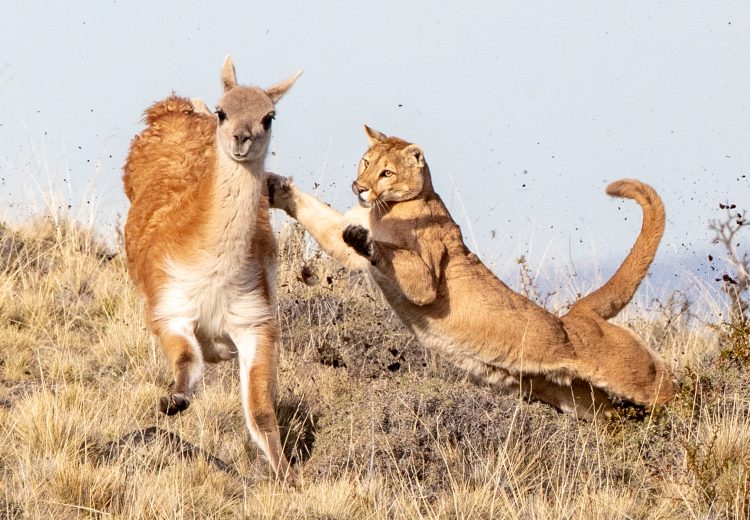
South America (including Galapagos)
September 2025
CHILE: WALKING WITH PUMAS – An Extraordinary Photographic Adventure at Torres del Paine
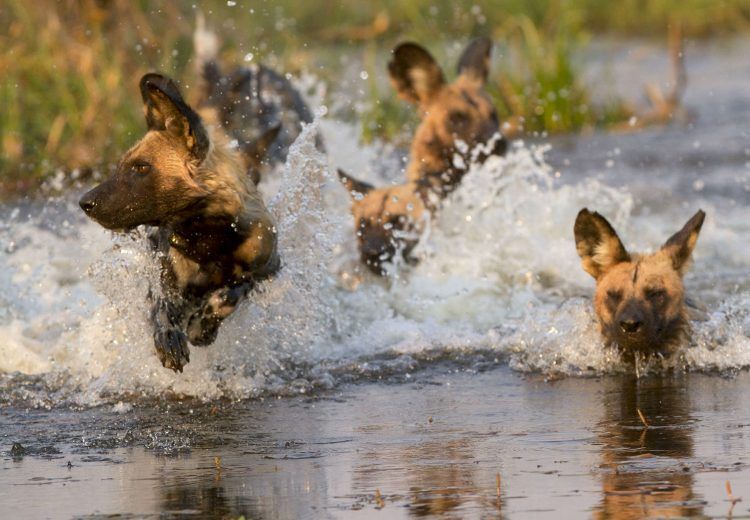
Botswana & The Okavango
November 2025















